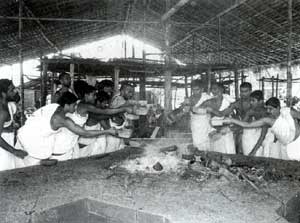


| Documentation |
Vedic Chanting: An intangible heritage
By the sustained efforts of the India Gandhi National Centre for the Arts, the oral tradition of the Vedas and Vedic chanting have been declared intangible heritages of the world. Since its inception one of the focus areas of the IGNCA activities has been the conservation, preservation and propagation of the intangible heritages of India, across the country and categories.
As part of this, the Centre has video-documented the rare and near-extinct tradition of Apthoaryaama Soma Yagam, conducted in Trissur, Kerala. The significance of this lies in the fact that this is one of the biggest of the seven important Soma yajnas known as Sapta Soma Samsthas. It is believed that this yajna was conducted after nearly 200 years.
This yajna is performed rarely as it involves an enormous number of rituals and recitations of thousands of Rg Veda and Yajur Veda mantras and the chanting of innumerable Sama Veda verses. (Sama chanters in themselves are a dwindling number.) Mantras from the Atharva Veda are also used in this yajna.
One of the important components of this yajna is the Garuda Chayana. The main fire-altar (Havan-vedi) for the yajna is constructed with one thousand clay bricks of different shapes and dimensions. They are piled in five layers, in the shape of an eagle with outstretched wings.
The yajna, documented by the IGNCA was organized by the Vedic Yajna Prathishtan, Mulankunnathukavu and Om Shanthi Dhama, Bangalore, with the co-operations of Sroutha Shashtra Parishad, Trissur. Scientists from several fields of study, from NIMHANS, ISRO, NAL, IISC attended the yajna to study the various effects of the rituals. The objective was to scientifically evaluate, revive and propagate the knowledge of the Vedas, to make known the philosophy of universality in the Vedas and Vedic practices. Their observations are being studied.
|
[ Newsletter | List of Newsletter ] |




